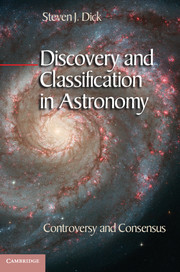Book contents
- Frontmatter
- Contents
- Preface
- Abbreviations
- Introduction The Natural History of the Heavens and the Natural History of Discovery
- Part I Entrée
- Part II Narratives of Discovery
- Part III Patterns of Discovery
- Part IV Drivers of Discovery
- 9 Technology and Theory as Drivers of Discovery
- Part V The Synthesis of Discovery
- Appendix 1 Astronomy’s Three Kingdoms
- Appendix 2 Astronomical Discoveries and Their Extended Structure
- Notes
- Select Bibliographical Essay
- Glossary of Concepts Related to Discovery
- Index
9 - Technology and Theory as Drivers of Discovery
from Part IV - Drivers of Discovery
Published online by Cambridge University Press: 05 August 2013
- Frontmatter
- Contents
- Preface
- Abbreviations
- Introduction The Natural History of the Heavens and the Natural History of Discovery
- Part I Entrée
- Part II Narratives of Discovery
- Part III Patterns of Discovery
- Part IV Drivers of Discovery
- 9 Technology and Theory as Drivers of Discovery
- Part V The Synthesis of Discovery
- Appendix 1 Astronomy’s Three Kingdoms
- Appendix 2 Astronomical Discoveries and Their Extended Structure
- Notes
- Select Bibliographical Essay
- Glossary of Concepts Related to Discovery
- Index
Summary
The history of astronomy has been defined by discoveries made with instruments of ever-increasing power (and cost). The exponential growth in capability of the telescopes has been crucial for maintaining the stream of discoveries in astronomy.
R. D. Ekers and K. I. Kellermann, 2011It would be a mistake . . . to opt for a technological determinism, according to which, in explaining the “successes” or “failures” of individual astronomers, the only issues in play were the sizes of telescopes available to them.
Robert Smith, 2009Because instruments determine what can be done, they also determine to some extent what can be thought. Often the instrument provides a possibility; it is an initiator of investigation.
Albert van Helden and Thomas Hankins, 1994Throughout our discussion of the discovery of new classes of astronomical objects we have seen both technology and theory at play, as well as other factors involving personality, social, and institutional context. The question now arises whether telescopes or theories are the primary drivers of discovery, or, indeed, if either of them are primary drivers given the other factors also in the mix. The question is of more than historical interest, for if discovery is the essence of science, and either technology or theory is the primary driver of discovery, then funding one or the other is a practical policy issue, especially in the era of big science and scarce resources. Indeed, astronomers routinely argue to funding agencies that bigger and more sophisticated telescopes will generate new discoveries, with all the subsequent rewards. But if this is true, does large telescope aperture accompanied by better detectors generate discoveries, or do other factors predominate?
- Type
- Chapter
- Information
- Discovery and Classification in AstronomyControversy and Consensus, pp. 279 - 312Publisher: Cambridge University PressPrint publication year: 2013



